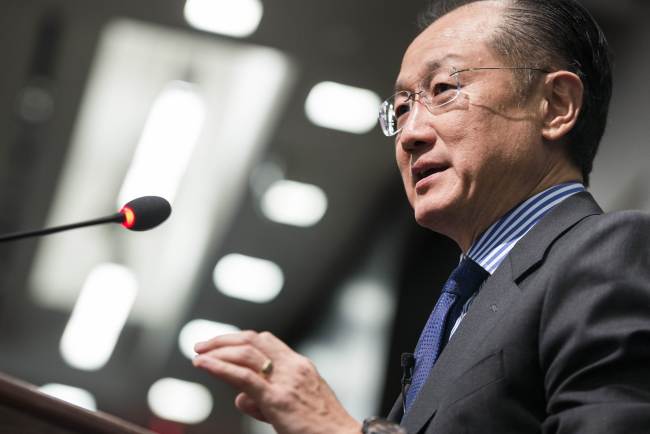 |
World Bank President Jim Yong Kim speaks at the Center for Strategic and International Studies in Washington, D.C., Tuesday. (AFP-Yonhap News) |
WASHINGTON (AFP) ― The World Bank on Tuesday raised its growth forecasts for the global economy, but warned of potential volatility in capital flows as the United States withdraws its stimulus.
In its latest Global Economic Prospects report, the World Bank said that both high-income and developing countries appeared to be “finally turning the corner five years after the global financial crisis.”
Global economic growth was estimated to hit 3.2 percent this year, accelerating from a 2.4 percent annual pace in 2013.
Growth was picking up in developing countries, supported by the more robust growth in advanced economies and China’s continued strong expansion.
“However, growth prospects remain vulnerable to headwinds from rising global interest rates and potential volatility in capital flows, as the United States Federal Reserve Bank begins withdrawing its massive monetary stimulus,” the development lender said.
The World Bank highlighted that growth in developing countries will pick up at a slower pace than previously anticipated. But that was “not a cause for concern” because the slowdown largely reflects a cooling off of “the unsustainable turbo-charged pre-crisis growth.”
Gross domestic product growth in developing countries was projected to rise to 5.3 percent this year from 4.8 percent in 2013.
High-income countries were expected to see GDP growth of 2.2 percent, following a sluggish 1.3 percent last year.
The 10-quarter U.S. recovery is the most advanced. The world’s largest economy was projected to expand 2.8 percent in 2014, a full percentage point higher than last year.
The 17-nation eurozone was seen exiting two years of contraction at a 1.1 percent growth pace this year.
“The performance of advanced economies is gaining momentum, and this should support stronger growth in developing countries in the months ahead,” World Bank President Jim Yong Kim said in a statement.
China’s growth was seen maintaining a 7.7 percent pace for the third year in a row this year as the government engineers a restructuring of the economy.
India’s GDP expansion was projected to accelerate to 6.2 percent this year from 4.8 percent in 2013.
 |
Produce being sold at a market in Kolkata, India. (Bloomberg) |
Growth prospects “will be sensitive to the pace at which extraordinary monetary support measures in high-income countries are withdrawn,” the World Bank stressed.
The Washington-based Bank said it assumed the Federal Reserve would scale back its bond purchases, or quantitative easing, in a relatively slow, orderly fashion as the U.S. economy improves.
The Fed, in announcing last month that it would taper its $85 billion a month in asset purchases, plans to start with a relatively modest $10 billion reduction in January.
The corresponding increase in global interest rates expected from the Fed taper would be offset by firming global trade, the Bank said.
“If, however, the taper is met with an abrupt market adjustment, capital inflows could weaken sharply ― placing renewed stress on vulnerable developing economies,” warned the 188-nation institution.
Under that scenario, capital inflows could drop by as much as 50 percent for several quarters, the Bank said, emphasizing the need for policy buffers and reforms to withstand such shocks.
With the Fed taper under way, policy-makers need to be prepared to respond to financial market pressures, including through tighter monetary policy and allowing currency depreciation.
“Still, to accelerate poverty reduction, developing nations will need to adopt structural reforms that promote job creation, strengthen financial systems, and shore up social safety nets,” Kim said.
The World Bank has set a goal of reducing extreme poverty ― people living with less than $1.25 a day ― to a maximum of three percent of the global population by 2030.









